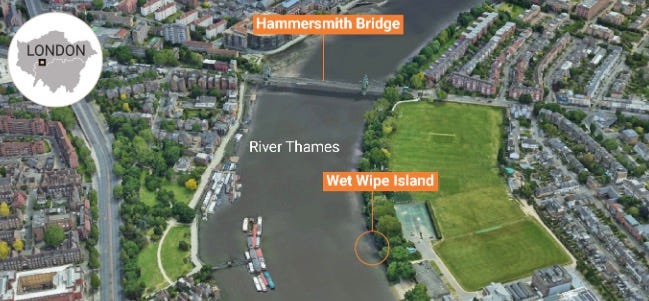Farewell to Wet Wipe Island
A month-long clean-up begins on the Thames foreshore between Hammersmith and Barnes – Story 120
It took a decade to grow, and will take a month to dismantle. On the Thames foreshore beside St Paul’s School, a dense mound of congealed wet wipes — ‘Wet Wipe Island’ — is finally being removed.
The Port of London Authority, working with Thames Water and the environmental charity Thames21, has begun extracting an estimated 180 tonnes of plastic-laced waste. The island is the size of two tennis courts, the weight of 15 double-decker buses and covers a 250-metre stretch of riverbank.
The island, formed from flushed wipes, fats and sewage, is in places a metre high. It has altered the river’s flow, damaged habitat and, for years, sat largely unnoticed except at low tide, when it appeared as a patch of muddy shore. In reality, it is a dense, synthetic carpet of human waste.
Wet wipe island had become ‘London’s newest - and grimmest - landmark’ and boasts its own Google Maps listing, as a cultural landmark.
How it happened
The story begins in our bathrooms. The Sunday Times reports,
In the UK we use 30.5 billion wet wipes every year, an average of 450 wipes per person, according to research commissioned by the Department for Environment, Food and Rural Affairs (Defra).
Despite many brands clearly displaying “do not flush” symbols on their packaging, every year billions of wipes end up in the toilet. Unlike paper, they do not disintegrate. In London, where Thames Water frequently releases untreated sewage into the river, wipes escape through overflows, they snag on debris, congeal with fat and oil, and form blockages.
This has been happening since the 1990s, when wet wipes first appeared in our supermarkets. Thankfully they took their time to reach our homes. The first commercial use of wet wipes in American was in 1963 by KFC. Mass production started the following decade.
John Sullivan, Thames Water’s head of tideway integration, says blockages from wet wipes are “a leading cause of pollution” and the company removes about 3.8 billion of them from its network annually at a cost of £18million.
This stretch of the Thames has proved particularly susceptible to wet wipes because of combination of flow of the river, the location of sewage outflows, and a bend in the river.
Thames21 began monitoring the site in 2017, recording the island’s growth and hauling away what could be removed by hand. Campaigning by Putney MP Fleur Anderson helped push the government to ban plastic in wet wipes, legislation she says will prevent those same 3.8 billion wipes a year from reaching the system. Boots and Tesco have already taken such products off their shelves.

The clean-up
This is the first large-scale, mechanical removal of wet wipes from a UK riverbed. An eight-tonne excavator is being driven across St Paul’s playing fields to work at low tide, scooping waste into skips for disposal.
Grace Rawnsley, the PLA’s sustainability director, calls the island ‘a source of environmental harm and an embarrassment to the capital.’ The removal is part of the authority’s Clean Thames Manifesto, which aims for a pollution-free river ecosystem by 2050. The clean-up is expected to cost hundreds of thousands of pounds. Thames Water, for its part, is investing in the £4.6 billion Thames Tideway Tunnel, intended to cut sewage discharges by 95%.
The removed waste will, essentially, end up in landfill and where traditional wet wipes containing plastic fibres can take 100 years or longer to decompose.
Notes & Thoughts
The Thames shaped Barnes and Mortlake in the past. It will shape them in the climate-changed future. It will help us cope when there’s even more sunshine or rain. Any version of my best life during this climate emergency demands it be protected.
Actions and consequences
People find it hard to connect everyday actions with large-scale consequences. Wet wipes are a perfect example: invisible, unconnected, seemingly manageable. Until you find an island. Then there’s a reaction. What is the equivalent to wet wipes for greenhouse gasses?
What price convenience?
Wet wipes are convenience culture made tangible. They save seconds in a bathroom, at a cost of decades in a river. Me versus we, again. And Wet Wipe Island is just one example of the cost of this convenience. A five-year study by Defra that found an average of 20 wet wipes on every 100 metres of beach surveyed across the UK.
Polluter pays
Wet wipe producers should be charged to remove their pollution from England’s waterways, the author of a government review into reforming the sector has said. Sir Jon Cunliffe, a former Bank of England deputy governor said adopting the ‘polluter pays’ principle was the fairest way to do this.
This principle is going to play an outsized role in mitigating climate change.
Sadly in this case, Although the UK government has pledged to ban wet wipes containing plastic, progress has stalled since last year’s general election.
Instead, the PLA and Thames Water plan to forensically test the composition of the wipes. The Sunday Times reports Grace Rawnsley saying,
If the wipes are fresh enough, we may even be able to identify the retailer or brand they came from.
Others need to step up, too
On the specifics, Thames21 CEO Chris Coode said,
Water companies must invest further in our sewage infrastructure so that it relies less on sewage overflows and install more screens to prevent wet wipes entering the environment.
Water bosses are urging us to play our part. We should limit what we put in the loo to the ‘Three Ps’ rule - pee, paper, poo.

